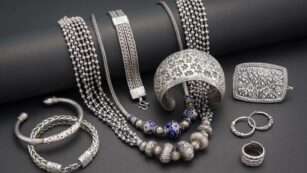
In the ever-evolving world of fashion, jewelry remains a crucial element that complements and enhances personal style. As we navigate through the current year, several standout trends have emerged, capturing the attention of fashion enthusiasts and designers alike. From bold, statement pieces to eco-conscious selections, the jewelry industry is witnessing a fascinating shift that mirrors broader societal changes.
Current Jewelry Trends
The latest jewelry trends embody a blend of contemporary flair with nods to traditional charm, reflecting key societal shifts. This section delves into the factors influencing current jewelry fashion and the predominant elements found in modern designs.
Influences on Today’s Jewelry Fashion
 Current jewelry trends are heavily influenced by a mix of cultural, technological, and environmental factors. Cultural resurgence, for example, brings vintage styles back into the limelight, with Art Deco and baroque pearls making significant comebacks. Technological advancements, on the other hand, allow for more intricate designs and customization, making pieces unique and personal. Additionally, a growing awareness of sustainability issues encourages designers to use recycled metals and ethically sourced gems, appealing to environmentally conscious consumers.
Current jewelry trends are heavily influenced by a mix of cultural, technological, and environmental factors. Cultural resurgence, for example, brings vintage styles back into the limelight, with Art Deco and baroque pearls making significant comebacks. Technological advancements, on the other hand, allow for more intricate designs and customization, making pieces unique and personal. Additionally, a growing awareness of sustainability issues encourages designers to use recycled metals and ethically sourced gems, appealing to environmentally conscious consumers.
The digital realm also plays a pivotal role. Social media platforms showcase global fashion trends rapidly, resulting in diverse influences converging in jewelry designs. Lastly, celebrity styles and major fashion events continuously shape preferences, as pieces worn by influential figures often set new trend directions.
Key Elements in Modern Designs
Modern jewelry designs emphasize minimalism, functionality, and versatility. Simple geometric shapes, such as circles, triangles, and hexagons, dominate, often combined in abstract or asymmetrical patterns. This focus on simplicity does not diminish impact; rather, it enhances the versatility of each piece, making them suitable for both casual and formal settings.
Material innovation is another crucial element. Beyond traditional metals like gold and silver, modern designers are experimenting with lightweight acrylics, ceramics, and even repurposed materials to create statement pieces that are both eye-catching and comfortable for daily wear. Textural contrasts within a single piece—mixing polished with matte finishes, for example—add depth and intrigue without overwhelming the design.
Additionally, there’s an increased emphasis on pieces that can adapt to multiple styles or uses. Transformative jewelry, such as detachable earrings or convertible necklaces, offers consumers cost-effective versatility, aligning perfectly with the “less is more” ethos prevailing in today’s fashion scene.
Stylistic Trends in Jewelry
Embracing Modern Minimalism
 As the world leans towards simpler, more refined aesthetics, jewelry design follows suit. Modern minimalism emphasizes clean lines, basic geometric shapes, and a monochromatic palette. Pieces such as thin stackable rings, simple bangle bracelets, and solitaire pendants dominate this trend. Designers favor functionality, with items that seamlessly transition from day to evening wear.
As the world leans towards simpler, more refined aesthetics, jewelry design follows suit. Modern minimalism emphasizes clean lines, basic geometric shapes, and a monochromatic palette. Pieces such as thin stackable rings, simple bangle bracelets, and solitaire pendants dominate this trend. Designers favor functionality, with items that seamlessly transition from day to evening wear.
Vintage Revival
Echoing the insights from past sections, the allure of vintage and retro styles continues to captivate. Jewelry pieces inspired by the Art Deco period or the Victorian era are reemerging with a modern twist. Chunky link chains, filigree patterns, and cameo pendants are notable examples. People appreciate these designs not only for their aesthetic appeal but also for their storytelling potential, adding depth to any ensemble.
Focus on Unconventional Materials
Aligning with the push for sustainability mentioned earlier, unconventional materials are now a cornerstone in contemporary jewelry making. Designers are increasingly experimenting with recycled elements and biodegradable materials. Jewelry made from reclaimed wood, recycled glass, and metals is not only environmentally friendly but also offers unique textures and colors.
Rise of Personalization
 Highly personalized jewelry pieces represent another significant trend. Consumers desire pieces that reflect their personal style or convey messages. Engravings, custom-cut gemstones, and bespoke designs cater to this need. As technology advances, customization becomes more accessible, allowing for detailed and intricate designs that maintain a personal touch.
Highly personalized jewelry pieces represent another significant trend. Consumers desire pieces that reflect their personal style or convey messages. Engravings, custom-cut gemstones, and bespoke designs cater to this need. As technology advances, customization becomes more accessible, allowing for detailed and intricate designs that maintain a personal touch.
Influence of Global Culture
Global cultural heritage leaves its mark on today’s jewelry designs. Artisans incorporate traditional crafting techniques from around the world, and motifs from African, Asian, and Latin American cultures are particularly prevalent. These elements provide a rich narrative behind each piece, celebrating diversity and craftsmanship which resonates well with contemporary audiences.
Each trend underscores the community’s shift towards integrating meaningful stories, sustainability, and personal expression into their jewelry choices, aligning seamlessly with the broader themes discussed.
